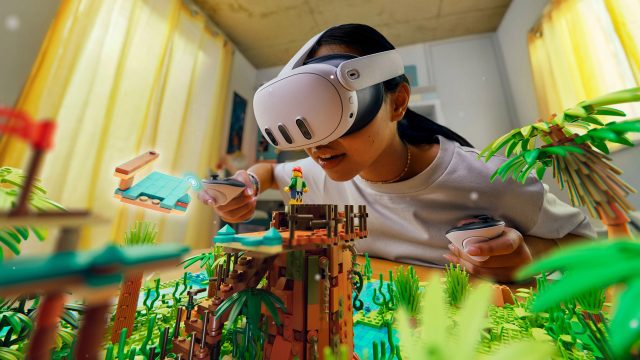LEGO Bricktales may not be a VR-native, as it was first released on flatscreen last year, but this Quest-exclusive port makes a pretty solid case that lego brick-building not only works in VR, but is something anyone can do for hours on end—even in the face of a pretty kid-focused story.
LEGO Bricktales Details:
Available On: Quest 2/3/Pro
Reviewed On: Quest 3
Release Date: December 7th, 2023
Price: $30
Developer: ClockStone STUDIO
Publisher: Thunderful Publishing AB
Gameplay
LEGO Bricktales isn’t just a big box of lego in VR where you can go wild—there is a sandbox mode for each bespoke puzzle, however no ‘free for all’ blank sandbox space to build whatever you want. The emphasis with Bricktales is definitely on building all sorts of functional things with one-off lego sets, such as bridges, furniture, statues and more, and doing it amid some classic RPG worldbuilding that includes a ton of linear quests and puzzles to solve.
The kid-friendly story will have you spending a lot of time engaging with characters via text-based dialogue and figuring out how to help out each of the little inhabitants in the world, all of which (if it matters to you) comes with zero combat.
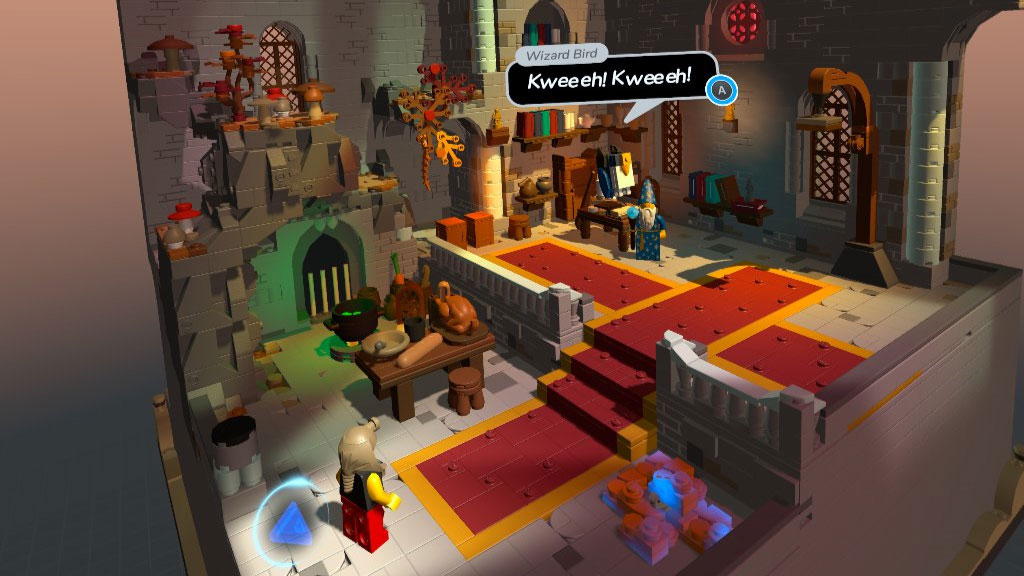
After all, you’re here to help restore the world by fixing things, and making everyone happy so you can… for some reason… fix your grandpa’s theme park with the power of happiness. Ok, that part is a little clunky, but it’s all in the name of honest, squeaky-clean fun that’s hard knock.
So, Bricktales is family-friendly fun, and it’s been largely admired for its light puzzling elements thanks to its clever block-building function. But how does that translate to VR? I would say surprisingly well—and that’s despite the inherent lack of tactility. When you’re prompted to build a model, you’re transported to a building space where you can grab pieces from a pre-set pile that you’ll need to attach to specific starting points. The objective below is to build a bridge from the blue arrow to the flag. Build it too wobbly, and it won’t past the stability test, making you reassess your design before going back to the world map.
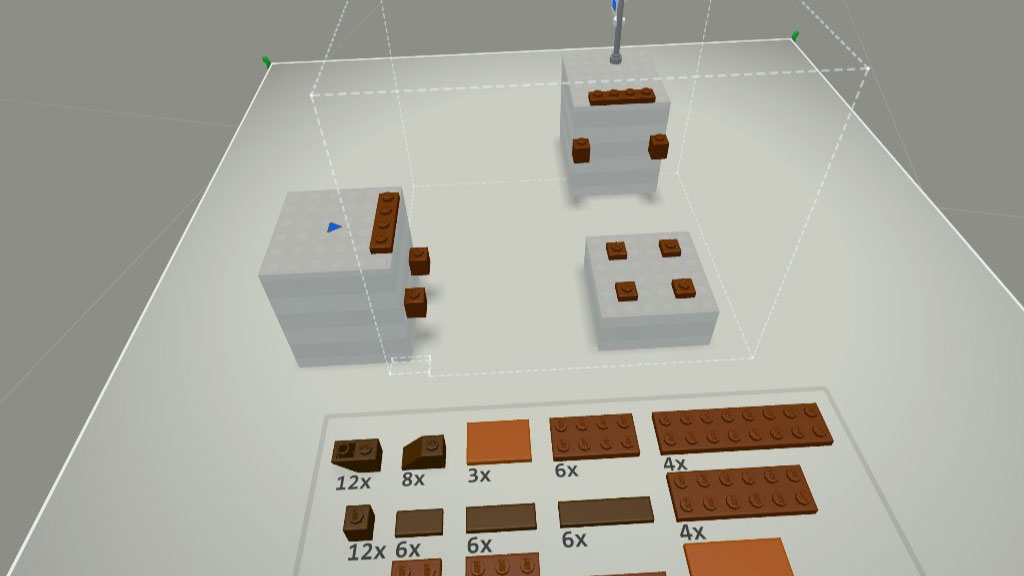
While picking up and using fiddly little pieces sounds like a nightmare in VR, the digital lego pieces thankfully only go in one specific orientation, so snapping them into place is satisfying, and rarely ends in a miss. Browsing pieces with the tips of your controllers, which are blue orb-like cursors, you can pick up blocks, place them, and highlight to remove pieces from models. To snap them into a different orientation, you can either physically move the piece, or hold it and use the right joystick to change positions.
The only thing missing really is a quick reset button for when you’ve completely screwed up a model, which instead requires you to dismantle and throw lego bricks off the map to reset them into their little hoppers. That’s pretty tedious, especially if you want to build something from the ground up again.
There are a good array of puzzle styles ranging from bridge builder-style affairs, like the one above, to fulfilling one-off tasks, like constructing a perfectly balanced perch for a giant bird or building a racecar. Watch out though, because you can’t just plop down whatever you want. Each building prompt comes with a few prerequisites. Here’s how a typical puzzle might go for a little helicopter you need to build:
- Attach the seat
- Attach the rotor on top
- Reach the finish line
- Nothing may break
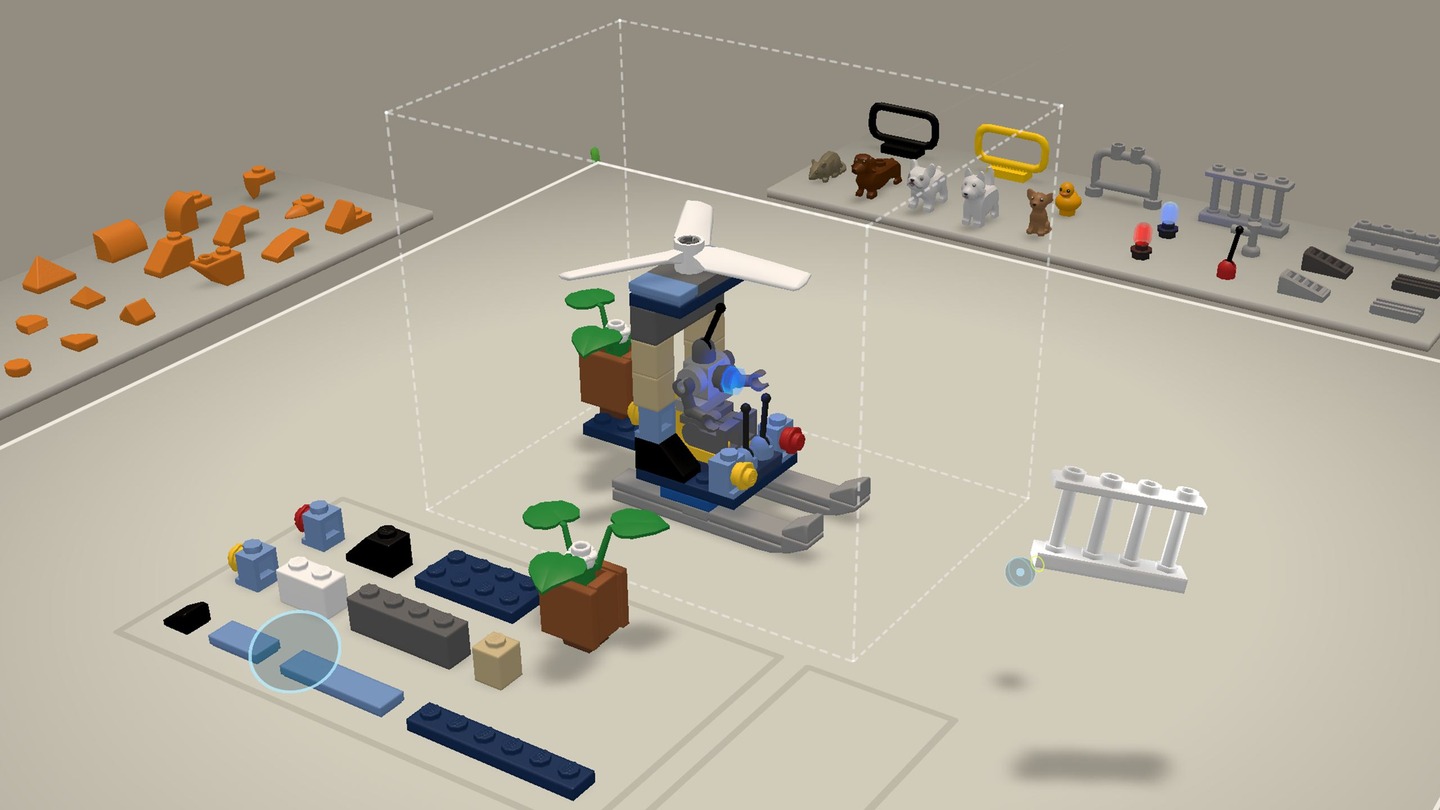
From there, you can build anything your imagination can handle (within the translucent wire cage), or equally just stick to the bare bones task to get past the hurdle. While none of the tasks are particularly hard (on flatscreen the game is suggested for kids 8+), all of them are gratifying in their own way, as they typically provide enough decorative pieces so you can not only build something functional, but embellish it with plenty of flair.
While fun in spurts, Bricktales also undoubtedly relies a ton on the cute factor of its little lego dioramas, all of which feel true to life. You can’t resize maps, which can either float in your living room thanks to mixed reality, or float in an unobtrusive skybox when played purely in VR. You can however twist and turn maps to get a better view for hidden pathways and so many easter eggs that you’ll be obligated to come back after the story is done, if only to see why that weird tree-man needs 20 chameleons. Seriously? Is what is he going to do with them??
Ok, as far as reasons for searching around the entire game for collectible extras goes, that’s fairly obtuse. Still, the “rated for ‘E’ everyone” age rating definitely means it’s geared towards kids, but snappy enough for adults to play too. Beware though, it’s not going to be the most engaging story, albeit harmless enough to act as sufficient narrative scaffolding that took me around six hours to complete. That’s just the story mode, so you can spend a lot more time rebuilding models and searching out the game’s many (many) collectibles, avatar skins, etc.

One of the definite misses with LEGO Bricktales is the lack of a dedicated sandbox. You can unlock a sandbox mode once you complete a bespoke construction spot. This lets you improve your model and also build with a growable selection of bricks from different biomes you explore along the way, but the true ‘sit down and build whatever’ feature would be great when you’re just looking to completely space out and build something of your own design.
Immersion
As you’d imagine, the whole word is made of lego, which is just so damn charming on its own. As a slightly-modified VR port of the flatscreen version, much of the praise you’ll find out there for Bricktales is also true here, but visually the Quest version has a definite leg-up on monitor versions. There’s something about the density of detail in the little dioramas that feels like really playing a game from the future.
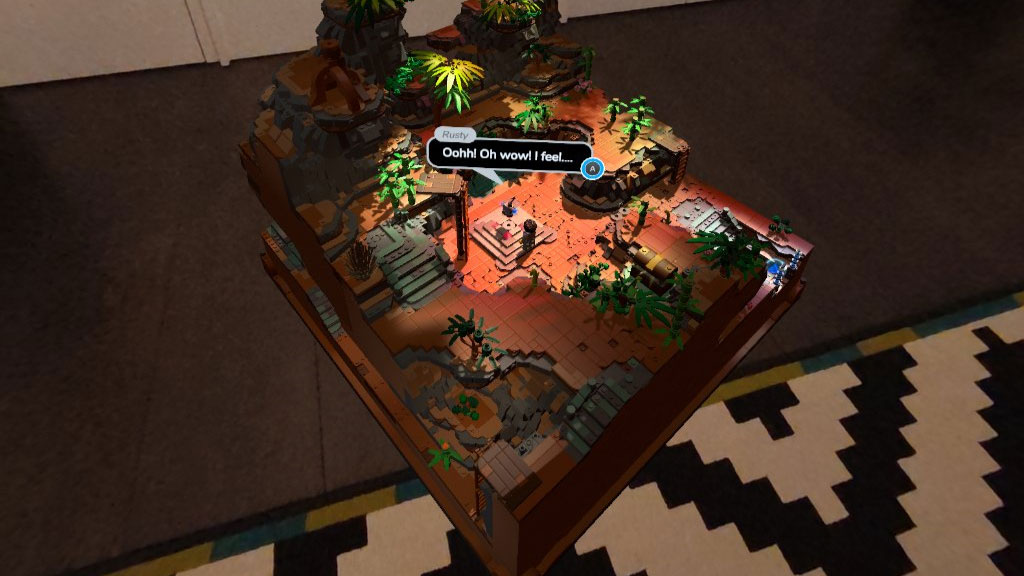
Both Quest Pro and Quest 3 have color passthrough, which can be more immersive than playing in straight VR, which features a pretty innocuous skybox. On the spectrum of gimmick to absolutely essential though, the mixed reality in Bricktales is much closer to the gimmick side of things, as it’s just a plain passthrough and no real mixed reality implementation that would make it more immersive (i.e. logo dudes knowing where you couch is or busting through your walls). Still, it’s a pretty great gimmick, considering the little lego pieces are all accurately sized to their real-world counterparts. It’s difficult to at least marvel once or twice that you’re remote-controlling a little lego dude on your living room floor.
That said, there are less VR-specific interactions than I would have hoped, as most of the time you’re hunched over at the model controlling your dude like an RC car with your left thumbstick. Here’s the only other ‘immersive’ control scheme in the game: a rotary valve that can turn things like statues, water valves, etc.
Substantively, the only other VR-specific adaptation from the original is your wrist-worn UI which clumsily lets you toggle through specific powers, leave the map to return to the overworld, and go through regular menu stuff.
Comfort
My first instinct was to hunch over and play the game like some sort of demigod looking over my little realm. The game is super approachable, and is designed for long playsessions, however it’s easy to lock into bad neck and back positions. Because VR headsets add extra weight that your neck has to overcompensate for, hunching over to play will fatigue your more quickly than doing the same action without the headset.
Granted, you can dynamically reposition the map to your liking at any point, so it’s more of a warning for players than a flaw as such. Otherwise, LEGO Bricktales is a very comfortable VR game since it lacks any sort of artificial locomotion, presenting you with an entirely static space.
‘LEGO Bricktales’ Comfort Settings – December 6th, 2023 |
|
Turning |
|
| Artificial turning | ✖ |
| Snap-turn | ✖ |
| Quick-turn | ✖ |
| Smooth-turn | ✖ |
Movement |
|
| Artificial movement | ✖ |
| Teleport-move | ✖ |
| Dash-move | ✖ |
| Smooth-move | ✖ |
| Blinders | ✖ |
| Head-based | ✖ |
| Controller-based | ✖ |
| Swappable movement hand | ✖ |
Posture |
|
| Standing mode | ✖ |
| Seated mode | ✖ |
| Artificial crouch | ✖ |
| Real crouch | ✖ |
Accessibility |
|
| Subtitles | ✔ |
| Languages | English, Simplified Chinese, Danish, French, German, Italian, Japanese, Korean, Portuguese (Brazil), Russian, Spanish |
| Dialogue audio | ✖ |
| Languages | n/a |
| Adjustable difficulty | ✖ |
| Two hands required | ✔ |
| Real crouch required | ✖ |
| Hearing required | ✖ |
| Adjustable player height | ✖ |

